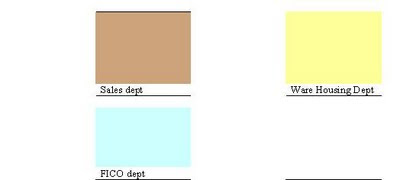· In goods issue, picking, packing, delivery can be maintained.
· After goods issued, sales dept can give bill and Invoice to the customer for payment. here bill & Invoice are almost are same.
With reference of invoice, In finance Department Account can be created.
|
|
|
|
· Based on Account Document, Finance Dept can collect payment from Customer. This is nothing but AR Process. (account rec).
SALES ORDER APPLICATION FORMAT
· In which table data is stored in KNA1 table
· In selection screen item entered customer account no
· Output is from so and so date to so..and so date list of sales order created.
· Sales order data is available is in VBAK, it is a predefined Table for Sales Order Header details
· Fields of VBAK ARE
VBAK
|
VBELN
|
sales order no(primary key)
|
ERDAT
|
date on which sales order created
|
KUNNR
|
customer account no(foreign key)
|
· In KNA1 table KUNNR is primary key where as in VBAK table it is a foreign key.
Requirements:
· In selection screen, sales order number, if enter any sales order no, output should be item is having in items, materials having, qty, price also
· Here VBAP is a predefined table for sales order Item details
· Fields of VBAP are
VBAP
|
POSNR
|
item no(primary key)
|
MATNR
|
material no
|
KWMENG
|
Quantity(qty
|
VBELN
|
sales order(foreign key)
|
Relation between Master Data(VBAK) and Header Data(KNA1):
· Based on Master Data user can maintain Header data
Example:
Sales Order can be created based on customer information
· Based on Header Data(VBAK) user can maintain Item Data(VBAP)
Example: Items information can be maintained under sales order No.
· Master Data(KNA1)+ Header Data(VBAK)+ Item Data (VBAP)equals to Transactional Data.
i.e. KNA1 + VBAK + VBAP = Transactional Data
· Sales Order Application is Transaction Data application, this can be used against Order placed by customer.
Requirement:
· In Selection Screen I can enter customer account no
|
Customer Accno
|
|
|
Master data
|
sales
· Output is the customer account no entered, here to this customer sales order, created by sales department on which date created.
· That is in briefly:
· Predefined tables using are: (i) KNA1 (2) VBAK.
· Here we are using two tables so use Inner Join concept
INNER JOINS
· Using INNER JOIN concepts data can be extracted from more than one table
· Internal Table Keywords using are
· Internal table Body have all records, where as Internal table work area has only last record only.
CLEAR:
Is a keyword which can refreshed memory of Internal Table work area.
REFESH:
Is a keyword which can clears Internal Table body memory
SORT:
SORT is akeyword which can sort output data as per required column.
INITIAL:
Means data is not there in body, it is keyword
NOT INITIAL:
Means data there in body, it is a keyword.
INNER JOIN FUNCTIONALITY
|
KNA1
|
|
VBAK
|
|
+
|
VBELN
|
ERDAT
|
KUNNR
|
100
|
--/--/--
|
1
|
200
|
--/--/--
|
2
|
300
|
--/--/--
|
3
|
|
INNER JOIN
|
· Kna1 table firelds kunnr , name1 fields., vbak tables firelds vbeln, erdat, kunnr
· First system can check master data table KNA1, system can check primary key field kunnr, now system came to know 3 customer are there in table
· System checks how many item have customer sales order, whichever customer field have sales order that data only it will be extracted
· Inner joins can extract common data only
Example:
INPUT IS
OUTPUT IS:
Customer Accno
|
Sales order
|
Date
|
CUSTOMER NAME
|
1
|
100
|
-----
|
X
|
1
|
200
|
----
|
Y
|
Demo on INNER JOINS
| 











No comments:
Post a Comment